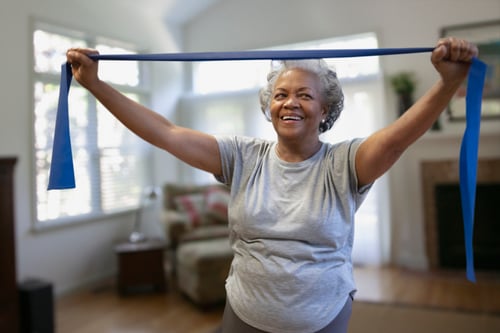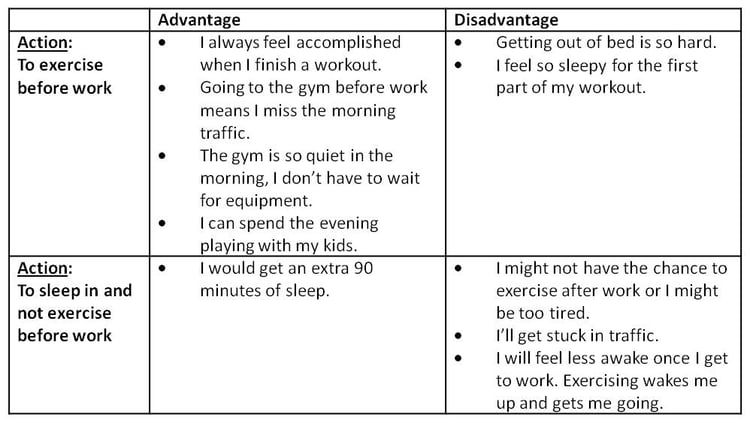Why use a GPS on a road trip? Why follow the instructions when putting together a dresser? I know California is south-west, I’m sure I could get there eventually. I also know what a dresser looks like. This line of thinking gets us stuck in New Mexico with a dresser that’s wobbly and, strangely, has extra screws. Changing a habit is a lot like taking a trip or building a dresser; sure, maybe you’ll stumble into success. But wouldn’t you rather have a GPS or step-by-step instructions? It seems like that would make everything simpler. Goal setting is our step-by-step guide to making lasting changes.
 Goal-setting’s impact has been defined in two ways; the first is the indirect thought-process view which states that “outcome, performance, and process goals influence behavior indirectly by affecting important psychological factors such as confidence and anxiety” (1). A study of swimmers found that those with high goal-setting ability exhibited higher confidence, less anxiety and improved performance compared to their peers with low goal-setting ability (2).
Goal-setting’s impact has been defined in two ways; the first is the indirect thought-process view which states that “outcome, performance, and process goals influence behavior indirectly by affecting important psychological factors such as confidence and anxiety” (1). A study of swimmers found that those with high goal-setting ability exhibited higher confidence, less anxiety and improved performance compared to their peers with low goal-setting ability (2).
The second is the direct mechanistic view and this view “specifies that goals influence performance in one of four direct ways; goals direct attention to important elements of the skill being performed, goals mobilize performer efforts, goals prolong performer persistence, and goals foster the development of new learning strategies” (1,3). Let’s say an individual wants to lose 50 pounds in 1 year. That’s a very big goal and a very long time frame; so, for example, we would break it down to 1 pound per week. Making the goal more manageable “mobilizes effort” because the progress is much easier to see than it was prior. If the individual kept staring at 50 pounds every day, they could eventually get discouraged and their effort could diminish; comparatively, 1 pound a week doesn’t seem too bad. During this process they were also exercising for the first time and learning the skills that go along with that, skills that wouldn’t have been learned unless they set their original goal. Setting a good goal is just as important as acting on it. To set a good goal we need to go over what makes a good goal and the steps required to get there.
We define good goals with the acronym SMARTS. Specific, goals should indicate exactly what wants to be achieved; Measurable, goals need to be quantifiable to track progression; Action-oriented, goals should indicate specific actions to achieve the stated goal; Realistic, the has to be achievable in the first place, if we shoot to high we just get discouraged; Timely, goals shouldn’t continue indefinitely, they should have a set time-table; Self-determined, goals need to be set by, or with input from, the individual themself.
Let’s continue with our earlier example of losing 50 pounds in a year, or 1 pound a week. The goal meets all the criteria except “action-oriented”; to improve upon this goal we must come up with a plan of action to ensure we reach the goal. A plan of action for this goal might be as simple as walking for 30 minutes a day, 3 days a week. The action plan is part also gives us sub-goals to meet along the way.
Think of a long-term goal like a staircase, we start at the bottom and our goal – losing 50 pounds in a year – is at the top. We must approach our goal one step at a time, just as we would the stairs. So, we break the goal into smaller parts to make it more manageable, but in the earlier example we only talked about outcome goals – losing 1 pound a week – there are two other types of goals that are just as important, process and performance goals.
Process goals are important because they teach us to value the process, so we don’t get discouraged if we miss our outcome. In our example the individuals process goals would be to walk 3 days a week for 30 minutes (the action plan). Every week they walk 3 days a week is a victory and should be treated as such. Process goals, like all goals, are fluid and should be adjusted as we progress. Say, for example, walking 3 days a week is no longer challenging. At this point we should adjust our goal and make it more challenging – the best goals are moderately difficult - by adding strength sessions, increasing frequency (days being walked) or intensity (hills/stairs, jogging or time walked).
Performance goals are about competing against yourself. In this instance a performance goal might be to walk more miles than you did last month. Our individual walked 12 miles in August; so, their goal for September is to walk 14 miles. Similarly to process goals, performance goals give us something else to focus on to reduce any anxiety we may be feeling about our desired outcome. It goes back to mobilizing effort; sub-goals like these give us something to strive for day-to-day, week-to-week, and month-to-month. They help us focus on the habit we’re building regardless of the result.
Goal setting is a skill; it takes practice to set good goals and be able to follow through. It is a universal skill that can be applied to your career or personal life, we’ve just chosen to talk about it through the lens of exercise today. Hopefully, you’ll take the skills mentioned here to heart because, I’d hate for you to wind up in New Mexico with a wobbly dresser and some extra screws.
Sources:
- Weinberg, Robert S., and Daniel Gould. Foundations of Sport and Exercise Psychology. Sixth ed., Human Kinetics, 2015.
- Burton, D. (1989). Winning isn’t everything: Examining the impact of performance goals on collegiate swimmers’ cognitions and performance. The Sport Psychologist, 3, 105–132.
- Locke, E.A., & Latham, G.P. (2002). Building a practically useful theory of goal setting and task motivation: A 35-year odyssey. American Psychologist, 57(9), 705-717.

.jpg?width=365&height=243&name=GettyImages-1778515577%20(1).jpg) As the festive season draws near, the anticipation of joy, celebration, and connection fills the air. Yet, for many of us committed to maintaining a healthy lifestyle, the holidays can also bring a sense of unease. The abundance of indulgent feasts, tempting treats, and busy schedules can pose challenges to our well-established routines.
As the festive season draws near, the anticipation of joy, celebration, and connection fills the air. Yet, for many of us committed to maintaining a healthy lifestyle, the holidays can also bring a sense of unease. The abundance of indulgent feasts, tempting treats, and busy schedules can pose challenges to our well-established routines. It is almost that time of year where people set goals for themselves but have a hard time following through with the goals or accomplishing them as time goes on. We have all been there before or know someone that struggles with executing their goals during this part of the year. Managing your time, being realistic when setting goals and supporting those goals can get tough as we go into the holidays. Here are a few ways you can avoid becoming stagnant and set your self up for success while finishing this year.
It is almost that time of year where people set goals for themselves but have a hard time following through with the goals or accomplishing them as time goes on. We have all been there before or know someone that struggles with executing their goals during this part of the year. Managing your time, being realistic when setting goals and supporting those goals can get tough as we go into the holidays. Here are a few ways you can avoid becoming stagnant and set your self up for success while finishing this year.
 Have you wanted to create a healthier lifestyle, but don’t quite know how to get there? Maybe you have tried before, but haven’t been able to stick to your goals? Or life has thrown you a curveball (hello COVID-19 lockdowns) and you got knocked off track. It can be hard to keep yourself motivated to make good decisions every single day. Instead of relying on self-discipline to make these changes, studies have found that taking those healthy goals and turning them into habits might be the most efficient way to enact the changes you want to see! Do you have any habits you want to add to your routine?
Have you wanted to create a healthier lifestyle, but don’t quite know how to get there? Maybe you have tried before, but haven’t been able to stick to your goals? Or life has thrown you a curveball (hello COVID-19 lockdowns) and you got knocked off track. It can be hard to keep yourself motivated to make good decisions every single day. Instead of relying on self-discipline to make these changes, studies have found that taking those healthy goals and turning them into habits might be the most efficient way to enact the changes you want to see! Do you have any habits you want to add to your routine?
 As a fitness manager, people frequently ask me how they can lose “this” as they aggressively squeeze their belly. In response with a smile, I ask them if they have a minute to talk about it. As common as this question is, it’s very hard to give an answer that satisfies. It’s a concern most of us have because we associate a trim belly with health. There’s no single magic pill, exercise, food, or ritual that will help bring back the desired abdominal aesthetic. Fortunately, there are several simple steps that can be taken to reach a healthier body composition. Here are three ways older adults can fight belly fat as they stay safe at home:
As a fitness manager, people frequently ask me how they can lose “this” as they aggressively squeeze their belly. In response with a smile, I ask them if they have a minute to talk about it. As common as this question is, it’s very hard to give an answer that satisfies. It’s a concern most of us have because we associate a trim belly with health. There’s no single magic pill, exercise, food, or ritual that will help bring back the desired abdominal aesthetic. Fortunately, there are several simple steps that can be taken to reach a healthier body composition. Here are three ways older adults can fight belly fat as they stay safe at home:
.jpg?width=401&name=Woman%20running%20in%20snow%20-%20GettyImages-894281874%20(1).jpg)


 In
In  That’s right, it’s okay to feel unmotivated! After all, it’s a natural feeling that extends to many aspects of our lives. How many of us really feel motivated to fold that last load of laundry? Or make our beds in the morning? Or write that last report of the month? At some point, we all struggle with motivation.
That’s right, it’s okay to feel unmotivated! After all, it’s a natural feeling that extends to many aspects of our lives. How many of us really feel motivated to fold that last load of laundry? Or make our beds in the morning? Or write that last report of the month? At some point, we all struggle with motivation.
 You know you want and need to have a regular plan for your exercise, but where do you begin to
You know you want and need to have a regular plan for your exercise, but where do you begin to